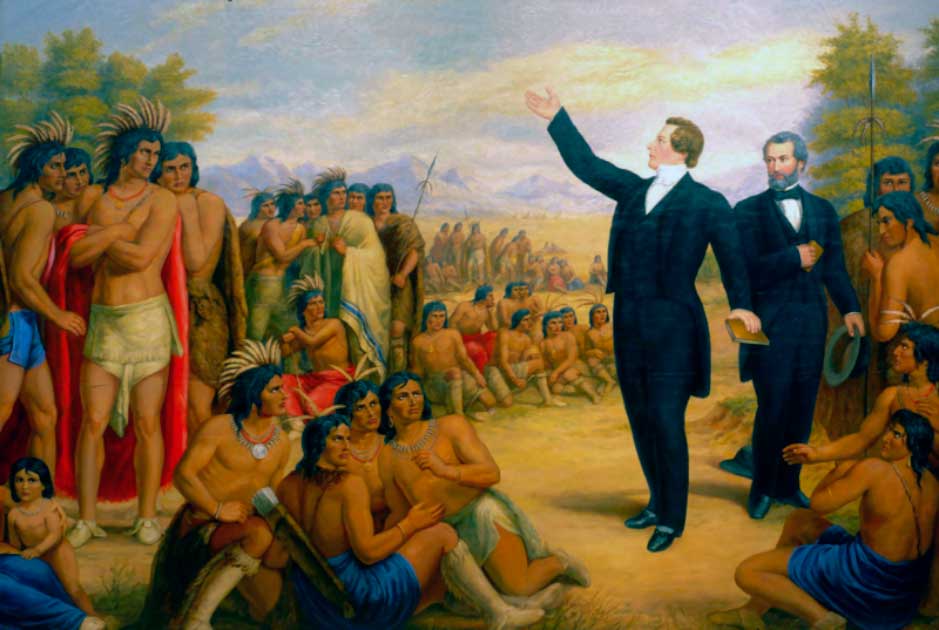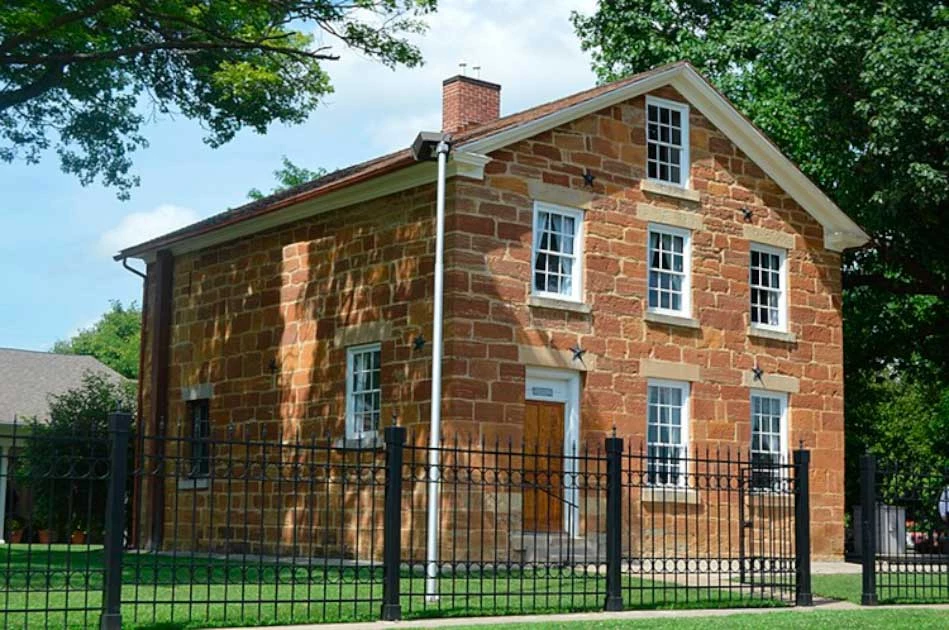The history of the Church of Latter-day Saints is a complicated one. Questions abound about what the religion is and isn’t, its beliefs and practices, differences between branches, and the frustrating question, “Which branch is the “real” Mormon Church?”
There are so many different branches of the Mormon Church as a result of one day in June 1844. The death of the leader and founder of the religion, Joseph Smith, significantly impacted the faith and our opinions about Mormons today. Why was the death of Joseph Smith so significant?
Joseph Smith Jr.
Joseph Smith Jr, the religious leader responsible for the founding of Mormonism and the Restorationist Christianity movement (Latter-day Saint movement), got started at an early age. At 24, Smith published his major religious book, The Book of Mormon, in 1830 after being visited by an angel.
Joseph Smith claimed to have received this visitation, by an angel named Moroni, who spoke to Smith about a long-lost ancient text. The text itself was said to have been engraved onto gold plates by a Native American historian in the 4th century AD.
The golden plates tell the story of the Israelites who lived in America during ancient times. In 1830, Joseph Smith founded the Church of Jesus Christ of Latter-day Saints (LDS or “the Mormon Church”), based on the teachings of his book.

Many non-Mormon people today associate LDS or Mormonism with its most controversial teaching, polygamy or plural marriages. While early in the history of the religion, plural marriages were common, today, only small fundamentalist branches of the LDS church still participate in plural marriages (for example, the FLDS Church).
The mainstream LDS Church has not endorsed the practice in the modern era, and will excommunicate followers who practice polygamy. According to the LDS’s website, the church explicitly states, “Today the practice of polygamy is strictly prohibited in the Church, as it has been for over a century.”
Joseph Smith’s Death
Joseph Smith died on June 27, 1844, from multiple gunshot wounds and a fall from a window of the Carthage Jail in Carthage, Illinois. Joseph Smith and his brother Hyrum Smith were murdered that day by an anti-Mormon mob.
Five men were indicted for the murders but were acquitted and faced no consequences. When he died, Joseph Smith was running to be the president of the United States. This means that Joseph Smith was the first presidential candidate to be assassinated.
Today, the Church of Jesus Christ of Latter-day Saints consider Joseph and Hyrum Smith martyrs in their theology. To understand why a mob attacked and killed Joseph, the events leading up to the arrest of Joseph Smith must be explained.
In 1839 the Mormon Church and its followers moved into Hancock County in Illinois in response to being forced out of Missouri. Joseph Smith was quite the politician and received a charter from the Illinois legislature for a new city, to be named Nauvoo.
The city’s charter granted the city a considerable amount of autonomy, approved the building of a university, and granted the city habeas corpus power. Habeas corpus established a fundamental right in the US Constitution to protect people from being unlawfully forcefully imprisoned.

In simpler terms, the power that requires a person under arrest to be brought before a judge or court to facilitate the release of the person unless there is proof or lawful grounds can be used to support the reason for the arrest. This meant Joseph Smith could not be extradited to Missouri, where the state had a warrant for his arrest.
Nauvoo was a place that guaranteed religious freedom, but to ensure this freedom the charter established the Nauvoo Legion, a local militia.
The Polygamy Scandle and the Nauvoo Expositor
Joseph Smith began discussing his thoughts and plans for plural marriage with his closest associates, including the first mayor of the city John C Bennett. Bennett was also the Assistant President of the church.
Bennett used his position of power and Smith’s idea of plural wives to “seduce numerous wed and unwed women.” When rumors of polygamy being practiced got loose, Smith forced the mayor to resign and placed himself in the vacated seat, as the second mayor of Nauvoo. Bennett left in fury, and would go on to publish serious allegations against Joseph Smith and the Mormons in Nauvoo.
Some former associates of Smith and people in Hancock County and the city of Nauvoo started a newspaper called the Nauvoo Expositor. They didn’t get very far, and the only issue published reported that Joseph Smith practiced polygamy.
It claimed he was already married to eight other women who were already themselves married. This first edition of the newspaper, and the expose within, led to public outrage. The Nauvoo City Council (which Smith, as mayor, was a member of) declared the Nauvoo Expositor a public nuisance designed to instigate violence against Smith and his followers.
In an overdramatic order, the City Council ordered the city marshal to destroy the Nauvoo Expositor and its printing press. The destruction enraged people who felt that the act violated the freedom of the press, and people pressed charges against Smith for treason and inciting riots.
Not one to back down, Joseph Smith declared martial law in June 1844. Smith ordered the city militia, which had around 5,000 members, to protect the city from anyone who attempted violence against Nauvoo and its residents.
That did not go over well, and the Governor of Illinois ordered Smith’s arrest for treason against the state of Illinois. In response, Smith traveled across the Mississippi river into Iowa. After people criticized Smith for skipping town, he returned and turned himself in.
Carthage Jail
Joseph Smith, accompanied by his brother Hyrum and friends and supporters of Smith, surrendered himself to the authorities and was locked away in the Carthage jail to await trial. These other men were not arrested, but they chose to be detained in the cell with Smith.
- Killed by the Freemasons? The Secrets of William Morgan
- The Detroit Occult Murders: What Happened to Benny Evangelista?
The governor ordered the local militia, the “Carthage Greys,” to guard the jail and dismissed rumors that the Carthage Greys had threatened Smith. On the morning of June 27, 1844, a friend of Smith visited him in jail and smuggled him a 6-shot pepper-box pistol for use if needed. The gun was most certainly needed.

Later that day a mob of around 200 armed men covered in black facepaint stormed the jail, and when a jailer mentioned the mob to Smith, he assumed it was his Nauvoo Legion coming to rescue him. But that was not the case.
The Carthage Greys outside pretended to defend the jail, and the mob rushed into the prison. Smith and his friends in jail tried to hold the door to the room they were in closed, but musket and revolver fire began immediately.
Hyrum was quickly shot through the door in his face and died instantly. Smith was said to have fired shots into the mob, but the facts get blurry from here out. Conflicting reports claim Smith shot three men, and the fate of those three men is unknown. Smith’s gun was also said to have jammed three times, unable to expel bullets, so it is uncertain who was injured and how.
After emptying his gun, Smith tried to escape out the window and was shot twice in the back and in the chest by musket fire outside the window. He fell from the window, and there are conflicting reports of what happened next.
In some accounts, the death of Joseph Smith was caused by the three gunshots, and he was dead before he hit the ground outside the jail. Others claim he died from the fall, and an eyewitness reported that Joseph Smith was still alive when he landed on the ground. Members of the mob propped Smith up against a well and acted as a firing squad, shooting Smith repeatedly.
The Impact of the Death
A succession crisis occurred after the death of both Joseph and Hyrum Smith. Hyrum was the Assistant President of the Church and was set to take over after Joseph died.
Since both men were murdered, three men stepped forward to fill the role of President of the Church. These men were James Strang, Sidney Rigdon, and Brigham Young. Rigdon was the oldest and highest-ranked member of the leadership and felt it was his job to fill Joseph Smith’s shoes.
Strang claimed that Smith wrote him a letter a week before he died naming him the successor. Young was the president of the government body of the Church (the Quorum of Twelve) and said that the Quorum gave Smith the authority as the leader of the church, so Young should succeed Smith.

The uncertainty of who would become the President of the Church and leader of the LDS faith created a schism among Mormons. A large majority of Mormons followed Young and relocated to what is now Utah, and the LDS church continued to exist and keep its name.
Mormons who followed Rigdon established The Church of Jesus Christ, and Strang’s followers created the Church of Jesus Christ of Latter-day Saints, aka the Strangite branch. Some Mormons felt that Joseph Smith III, the son of Joseph Smith Jr, should have taken over after his father died. These members created the Reorganized Church of Jesus Christ of Latter Day Saints, aka RDLS Church, and later renamed itself the Community of Christ. Because of this schism, there are many different kinds of Mormonism, some very fundamentalist and others that want to forget the past polygamy issue.
Top Image: The Death of Joseph Smith outside Carthage jail. Source: CCA Christensen / Public Domain.
By Lauren Dillon